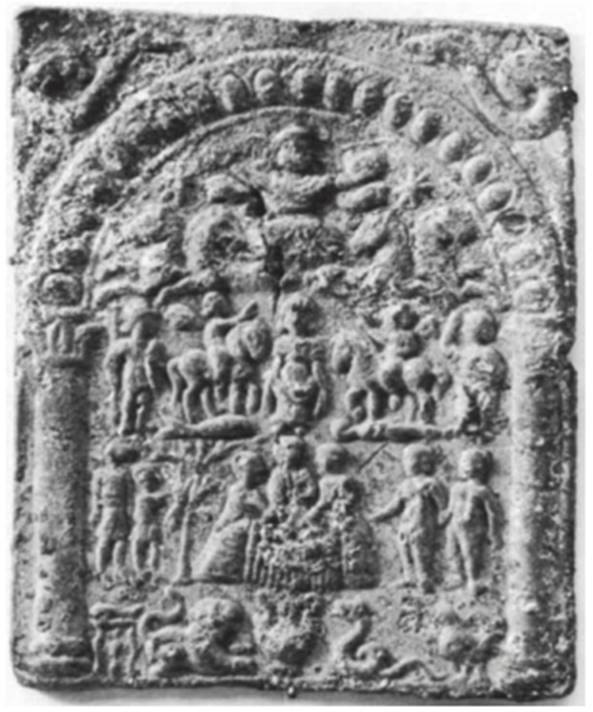Plaque with the Danubian horsemen. Danube Basin, 1st half 3rd century. Lead
This small plaque is covered with a thick layer of corrosion products, causing uneven discoloration and rendering some minute details indistinct. There are several surface cracks and an irregular hole below the upraised right arm of Helios; the upper left corner is curled forward, and all the edges are rough, with one notch midway along the right side.
An arch, with twisted snakes in the spandrels, is filled with a large number of figures arranged in four registers: on top, Helios, with a radiate halo and arms outstretched, stands in a quadriga. He carries an orb (and a whip ?), and his mantle flies out on both sides. Eight-pointed stars appear above the horses (cf. no. 61).

In the center of the next register stands a female figure dressed in a belted chiton (and himation ?) holding a cloth draped across her knees. Symmetrically arranged equestrian figures with windswept mantles salute her; the horse to the left stands on a fish, the one to the right on a human body. The scene is enclosed by a soldier with shield, spear, and helmet, and a woman with raised right arm.
The third register has three scenes: in the middle, three men are seated around a table, with their right arms extended toward an object, probably a fish, judging from replicas of this type. To the right, two nude youths, holding hands, face the central scene; to the left, a man flays an animal hanging from a tree, while behind him a taller man with a ram's head mask stiffly attends.
Along the bottom, a krater is flanked by a lion and a snake, and the row is filled out by a tripod table with a fish on top and a cock.
This small tablet is one of a large number of closely related cult images and ex-votos with a heterogeneous, often crowded, conglomeration of symbols and scenes. These artifacts constitute the only extant remnants of a syncretistic religion named after the Danubian horsemen, its most distinctive and consistent feature and after the area from which most of these monuments come. The beliefs, rites, and social context of this composite cult cannot be clearly determined, but some sources of symbolism are easily identified, such as the worship of Helios (sun god in quadriga) and Mithras (krater, lion, snake, cock, sacred meal).
Combined with the other images, which relate to celestial, terrestrial, and chthonic realms, they imply a complete cosmology arranged in an architectonic hierarchy, consistently set forth on most of the monuments. These plaques seem to be products of the frequent displacements of both the military and civilian populations during the third century along the constantly disputed Danube border. The hairdo of the woman in the second register recalls that of some later Severan women, suggesting production in the second quarter of the century.
There are twelve known replicas of this plaque, which implies one place of mass-production. Most of them were found in Yugoslavia (ancient Pannonia), near the Danube; one, now lost, was discovered in France. This plaque was bought in Rome. Bibliography: Alexander (2), 1931, pp. 148-150, figs. 1, 2; Tudor, 1969, no. 185.
Date added: 2025-08-31; views: 91;
